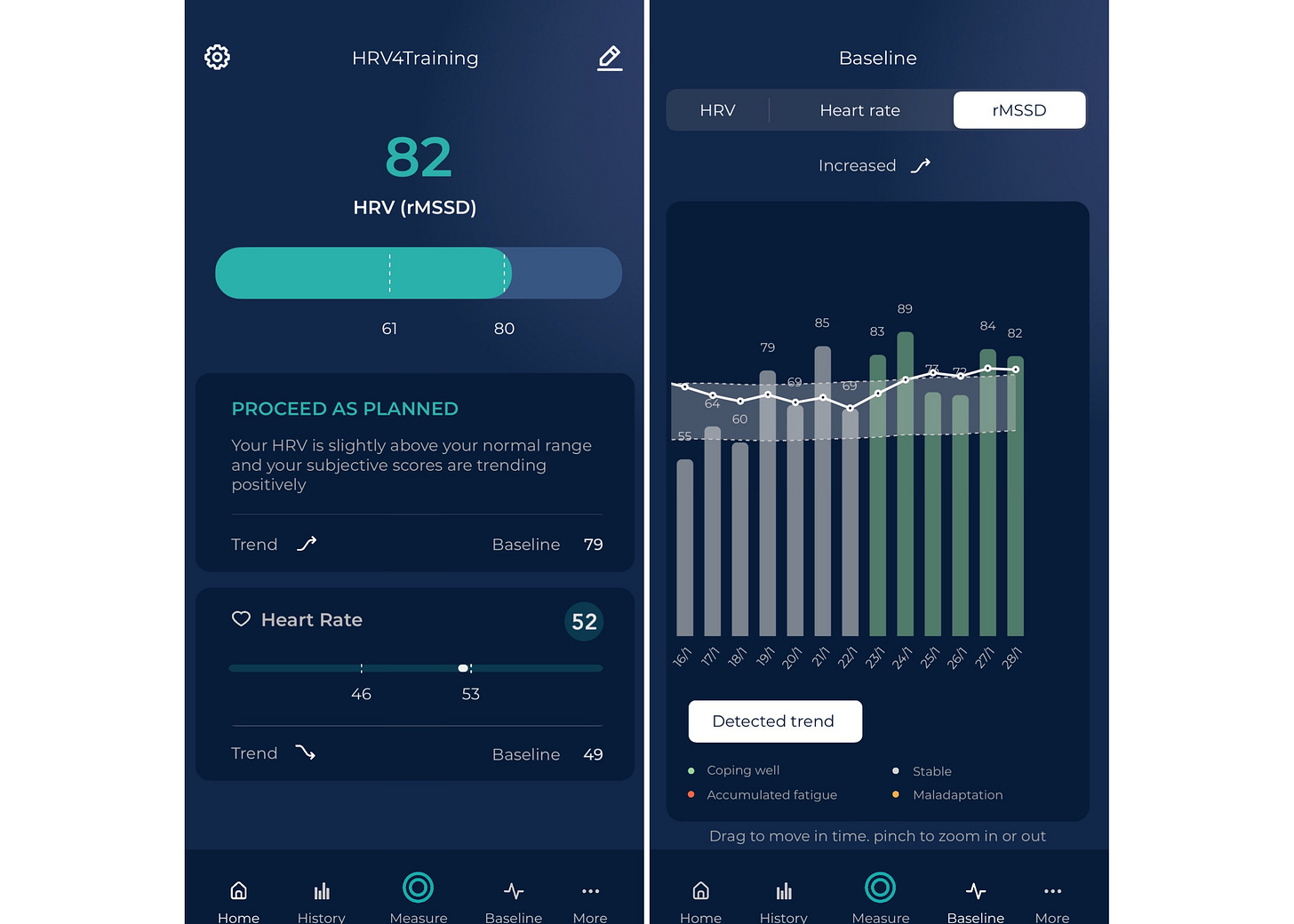In a recent blog, I covered some of the differences between morning and night heart rate variability (HRV) measurements (you can find it here).
In this short blog, I’d like to show you an example of how night data is often ineffective at capturing your readiness for the day, as it is too tightly coupled with the previous days’ stressors, even when irrelevant in the context of training (or worse, when the “stressor” is actually beneficial for your training).
Case study
Yesterday I had a busy day and a very early, light dinner. Eventually, I was pretty hungry later in the evening and decided to top up my carbs before the hard workout I had planned for this morning.
When eating later or relatively close to bedtime, your heart rate will be higher and your HRV lower, impacting the night averages. This is not good or bad, it is just digestion.
Above is my data from yesterday night, where we can see a clear re-normalization in the last few hours of the night, with values that are in line with my normal ranges for night data (42-47 bpm for heart rate and 64-79 ms for HRV, as shown in HRV4Training below).
However, if I use that data to determine my state for today, I would get an abnormally low HRV, and abnormally high resting heart rate, as shown below (this is a screenshot from the version of HRV4Training that I use to read night data from Oura or Garmin).

Am I really in a more stressed state, because I had a tortilla last night? Or is this data simply too close to the stressor to provide any meaningful advice?
We can find out by measuring HRV in the morning, and see if indeed I do have a suppression, or if everything is fine.
When measuring my HRV in the morning, while sitting, I can capture the actual state of the body when it is relevant the most: farther away from the previous days’ stressors.
And indeed we can see that physiology is perfectly normal, with HRV stable on the high end of my normal range. Measuring in the morning, we can assess how we have responded, and our actual readiness, which is not something we can do when measuring during the night, on many occasions.

If we want to use the data effectively, it is very important to understand these differences and to question methods that are heavily marketed, but fall short when analyzed critically.
In my opinion, if you care about using the data to understand your training response, the night is not the best time for this measurement. Real life is not a lab study, and we cannot assume that night data will reflect baseline physiological stress if there are any late stressors. This is simply due to measurement timing: the night comes too close to the stressors. On the other hand, measuring in the morning, after the restorative effect of sleep, gives us more actionable information for the day ahead.
Keep in mind that if we experience large negative stressors, they will still show up in morning data as well, as it would be the case for e.g. excessive alcohol intake, sickness, etc.
Eventually, I had a pretty good day out there. My guess is that the extra carbs helped, not the other way around as suggested by night HRV data.
Less is more: why are we measuring HRV?
When people get overly excited about HRV, they want to measure it all the time.
In these cases, I often push back. When it comes to continuous HRV measurements, it feels like the outcome would often be apathy or avoiding all stressors so that your HRV is never suppressed. That’s really not the point: stress is good, but we need to bounce back from stress quickly, otherwise, it means that the stressor was too strong, and we risk ending up in situations of chronic negative stress (overtraining, burnout, etc.).
How do we determine if we bounced back? We measure far from stressors, but still within a reasonable time (e.g. 4-12 hours). This is why morning measurements are what I recommend: you measure once, and you measure far from stressors, but on a daily basis. If you faced stressors and you responded well, your data will be within your normal range, and that’s all there is to know. If you have not bounced back, then it is time to re-assess the training stimulus provided in the context of your fitness and non-training-related stressors.
Less is more when the goal is to assess our state and provide actionability for the day (e.g. if we want to make a change to our training plan). More data does not give you more actionable information: quite the contrary.
Other applications
This is not to say that measuring at other times or during the night is not useful. Long-term changes in morning and night data are very similar. For the reasons mentioned above (close proximity to the stressors), night data might give us some insights into our behavior. Measuring at various times during the day could also be useful if we want to investigate a stressor acutely.
However, these measurements do not tell us much about our underlying physiological stress level (because they are too close to the stressor) and therefore are not actionable in the context of training guidance.
If you work in a team and your athletes play late evening games and have questionable lifestyles, what are you measuring with wearables? Probably not their training response and readiness. Similarly, unless you eat at 6:30 pm, go to bed at 9:30 pm, never exercise after 11 am, and never get stressed in the evening, night data might not be actionable for training guidance.
Here is a question to ask yourself: what do you want to do with the data? If the answer is assessing training responses and guiding training, then you might be better off measuring in the morning.
I hope this was informative, and thank you for reading!
Marco holds a PhD cum laude in applied machine learning, a M.Sc. cum laude in computer science engineering, and a M.Sc. cum laude in human movement sciences and high-performance coaching.
He has published more than 50 papers and patents at the intersection between physiology, health, technology, and human performance.
He is co-founder of HRV4Training, advisor at Oura, guest lecturer at VU Amsterdam, and editor for IEEE Pervasive Computing Magazine. He loves running.
Social:









Great Insights marco , well done in explaining HRV measurement in a nutshell <3
Thank you! Is it possible to track night HRV (from Oura) and morning HRV (by Polar H10) in one HRV4Training app account? (or it is only possible to have 2 apps and accounts)?